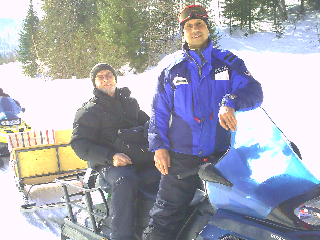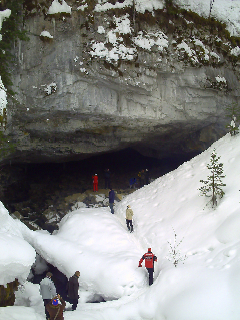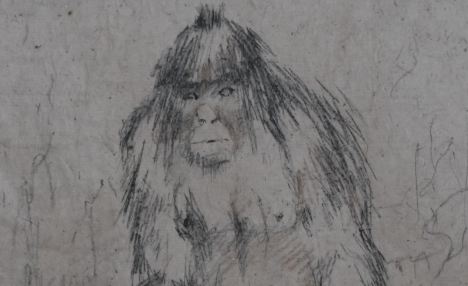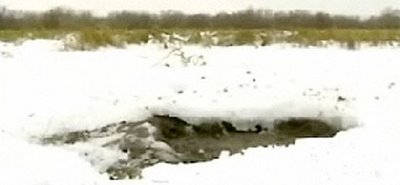
March 23, 2011


Are there even Yetis in Siberia?

One of the world’s worse Siberian Snowman reconstructions.
The Russian enjoy calling their reported hairy hominoids by the names “Snowman” and “Yeti,” although most people associate the Abominable Snowmen and the Yeti with the mountains, like the Himalayas, in and around Tibet, Bhutan, Sikkim, and Nepal. It has been that way for a long time. Back in the 1950s, the USSR established the Snowman Commission, and then before the end of the 20th century, the Russians created the Center for Hominology at the Darwin Museum in Moscow.
Now comes word that there is going to be the Yeti Institute at The Kemerovo State University. The host university was established in 1973 as a successor to Kemerovo Pedagogical Institute. It is a leading educational and scientific center of Kemerovo Oblast, Russia, with five branches throughout the region in Belovo, Anzhero-Sudzhensk, Novokuznetsk, Prokopyevsk, and in Ulan Bator (Mongolia). The main campus has 17 educational laboratory and administrative buildings with the total space of 120,000 m. There are 20 departments, 70 chairs, with over 10,000 full-time students (500 of them post-grad and doctoral students), with a grand total of about 21,000 students including part-time, and over 900 faculty members. This university holds between six and ten Russian and international scientific conferences annually. The annual number of scientific publications runs up to over 1,500, including 600-700 articles in the central press.

The Daily Mail reports that the university research institute is being formed to study the “Yeti after a spate of claimed recent sightings in Siberia.”

Scientists say they have found 15 witnesses in the past year who gave statements that they saw the Abominable Snowman in one remote area.
‘We spoke to local residents’, said Dr Igor Burtsev, who conducted an expedition last summer and will head the new institute at Kemerovo State University. ‘They told us Yetis were stealing their animals.’
The academic claims around 30 Yetis live in a remote region of Mount Shoria in in southern Siberia.
He strongly denies accusations that the ‘sightings’ are a bizarre ruse to attract tourists to the far-flung region.
Reports say the two-legged creatures are heavy-set, more around 7ft tall and resemble bears.
‘Their bodies were covered in red and black fur, and they could climb trees,’ said one account.
One villager, Afanasy Kiskorov, even claimed to scientists that he rescued a Yeti on a hunting trip a year ago.
The creature was screaming in fear after falling into a swollen mountain river, he said.
His version suggested a ‘strange creature, looking like a huge man which tried several times to get out of water and to stand up on both feet, but dropped into the water each time and was howling’.
As his fellow-hunters ‘froze’ in amazement, Kiskorov held out a dry tree trunk.
‘The creature clutched to it and crawled to the bank,’ he said.
The Yeti allegedly then ran off. This ‘sighting’ was in the Tashtagol district of the Kemerovo Region, only accessible by helicopter. However, no photographic evidence exists.The Daily Mail


On the trail: Scientists believe there could be a community of up to 30 unknown hairy hominoids existing in the remote Russian wilderness.

Russian Scientist: Igor Burtsev will head the new Yeti institute at Kemerovo State University.



A gallery of alleged Siberian Snowmen tracks.
Burtsev told the media of his theory that “Yetis” are surviving Neanderthals, a favored hypothesis of Russian hominologists. He said about thirty Russian scientists from across Russia who are “engaged in studying the phenomenon of the Abominable Snowman…will be integrated into this institute,” with their primary goal to “establish contact” with one of the hominoids, noted the Daily Mail.
We wish them well, and hope they achieve their objective. I would like to establish cooperative efforts between the Yeti Institute and the International Cryptozoology Museum, needless to say, in a worldwide interactive organization of cryptozoological groups.


About Loren Coleman
Loren Coleman is one of the world’s leading cryptozoologists, some say “the” leading living cryptozoologist. Certainly, he is acknowledged as the current living American researcher and writer who has most popularized cryptozoology in the late 20th and early 21st centuries.
Starting his fieldwork and investigations in 1960, after traveling and trekking extensively in pursuit of cryptozoological mysteries, Coleman began writing to share his experiences in 1969. An honorary member of Ivan T. Sanderson’s Society for the Investigation of the Unexplained in the 1970s, Coleman has been bestowed with similar honorary memberships of the North Idaho College Cryptozoology Club in 1983, and in subsequent years, that of the British Columbia Scientific Cryptozoology Club, CryptoSafari International, and other international organizations. He was also a Life Member and Benefactor of the International Society of Cryptozoology (now-defunct).
Loren Coleman’s daily blog, as a member of the Cryptomundo Team, served as an ongoing avenue of communication for the ever-growing body of cryptozoo news from 2005 through 2013. He returned as an infrequent contributor beginning Halloween week of 2015.
Coleman is the founder in 2003, and current director of the International Cryptozoology Museum in Portland, Maine.
Filed under Abominable Snowman, Almas, Breaking News, CryptoZoo News, Cryptozoologists, Cryptozoology, Evidence, Expedition Reports, Eyewitness Accounts, Folklore, Footprint Evidence, Forensic Science, Men in Cryptozoology, Yeti